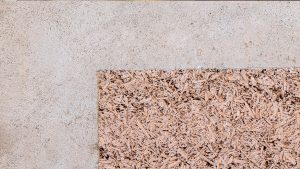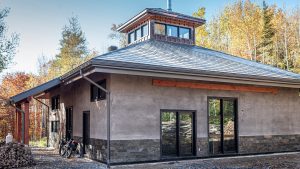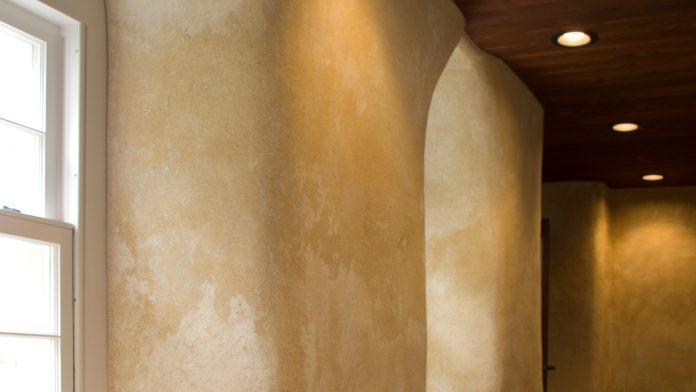Gabriel Gauthier, Director and Developer at ArtCan, explains the key features of the hemp construction industry and the benefits of using hempcrete.
ArtCan and Gabriel Construction Chanvre are pioneers and leaders in the development of hemp construction (hempcrete) and lime coating finitions in the provinces of Quebec and Ontario, Canada. They have taught and managed over 200 craftsmen in the housing industry, as well as in public and private spaces. They have introduced hemp into working areas such as Yoga studio, offices, theatre rehearsal rooms, and classrooms, in addition to the restoration of churches and other old buildings. In some projects, the companies have been involved from conceptualisation right through to the realisation (a complete hemp house and renovations to others, for example), while in other projects they have been called on to utilise their expertise for the purposes of aesthetics and/or health and safety or environmental aspects.
ArtCan
ArtCan has been an active company in the hemp construction industry for the last 20 years in Canada. The company’s mission is to apply, share, and offer traditional knowledge and experience to help develop organic buildings whose implementation techniques and radiance offer global beneficial qualities.
The ArtCan R&D Inc enterprise works in the research and development of ecological and alive construction materials made of hemp cellulose fibre and other plant fibres rich in silicon oxide that are favourable to masonry. The enterprise also works in collaboration with partners on the biosource composites materials of the future, as well as in several projects concerned with extractible and green chemistry.
Gabriel Gauthier, CEO and founder of ArtCan Group, began as an assistant to the master hemp builder Yves Kühn, founder of Canosmose in France, where his company was the first to develop the hemp infill process. Kühn developed this and went on to introduce untreated hemp into building industry.
The three years that Gauthier’s spent with Kühn was rich with experiences. Kühn’s company, founded in 1988, began properly undertaking construction and restoration work around a decade later, with great success. Gauthier worked on many of these projects with passion and quickly learned the best way to build things like hemp walls, hemp roofing, a hemp floor (slabs), hemp coatings, and others lime finitions. He went on to become Kühn’s assistant on formations, start up, R&D projects (high class finitions, the development of bricks and blocks from prototype to the production, and many new binder trials and research on #better process-dosage). In 1999-2000, he was employed as a foreman and teacher on hemp construction and formations for craftsmen and builders in France and Switzerland.
Hemp culture
Gauthier studied at the ITAA (Institut de Technologies Agro-Alimentaire de St-Hyacinthe, Quebec) and discovered the potential of the agro-environmental economy during his studies in 1995. Alone, he visited many hemp farmers and processors in France and Canada. Since 2012, he has supported 30 farmers and researchers in the production of hemp varieties for grains and fibers on more of 540 acres in Quebec and other provinces. He has been involved in all areas, from the quantity of seeds needed to the co-ordination of the harvests, to treatment and storage. This experience has provided him with a global vision of the many important investments that are needed in the hemp industry’s infrastructure in Quebec and Canada across the value chain.
Gauthier has also become active in hemp processing, as well as in areas such as canvassing, developing strategies, logistics, and actions plans as the hemp sector has continued to evolve. Moreover, he is very active in the development of hemp building products, which forms the core of his business, as well as the machinery to enhance efficiency.
Along with his partners, Gauthier has worked to elaborate and improve the applications, process, and technological transfer in the sector, with local considerations. For instance, a team of engineers are now working on a programme of experimental development. They are also harvesting data about the comportment of hempcrete, optimising the conception of composites materials and shell houses being built, and supervising trials in situ. Many internal projects also concern hemp building materials for insulation and finish, while there are also collaborations with researchers, universities and laboratories within the CRSNG programme to develop of fine tune hemp as a building material.
Gauthier has also been the Strategic Advisor for the Global Hemp since 2015 and, more recently, he invested in the Hempen Valley and LIVAC projects, which aim to start a non-woven factory to provide auto parts to a Japanese car builder and begin a research and development cluster with universities around the world to explore the future of hemp material, respectively.

Why use hemp in construction?
A bridge between ecological agriculture and ecological construction
Hemp is an annual culture which doesn’t fear competition thanks to it being robust. Nor does it require pesticide treatments. Hemp is the number one choice for the control of unwanted plant growth and cultivation rotation.
It is a fact that hemp can play a key role in reducing greenhouse gas emissions and stock carbon challenges. Moreover, compared to a forest, hemp will be four times as productive in biomass for the same surface. Therefore, it is a very generous cultivation that offers great solutions to abusive deforestation and in the fight against climate change.
The warm comfort of hemp
Quebec is the province in Canada with a long and rough winter. The hempcrete Cananalliance that ArtCan works with is a vegetable-mineral material that offers enhanced stability, softness, and comfort. One of the main advantages of using hemp as the basis of a construction material is the unique and warm comfort that hemp cellulose fibre brings. This fibre is very rich in silicon oxide, actually being riddled with quartz crystals that radiate light and warmth. This is confirmed by exceptional results when it comes to energy effectiveness. On average, we could observe 50% in energy saving when an intervention is done to insulate an exterior shell with our products.
Technical qualities
Because the material is rich in silicon oxide, it has a very favourable behaviour when it comes to masonry; its great absorption capacity brings important technical advantages.
The formwork technique is also very efficient and allows a great amount of architectural creativity as well as the flexibility required for the creation of curves.
A higher quality
The durability of this vegetal-mineral material cannot be doubted; for many centuries, the use of clay and lime has proven itself. Indeed, entire towns have been built with this technique – which Italian masons call ‘loving marriage’. Adding to all these advantages are its animal repulsive and non-flammable characteristics.
Other qualities that stem from the use of hemp in construction are : comfortable and conducive to wellness; favourable and adapted to masonry as a replace for aggregates and to decrease pressure on sand; breathable; durable; repulsive to harmful animals; and non-flammable.

Technical services
In order to ensure accessibility, ArtCan offers a complete range of services for hemp construction. You may choose the appropriate technical assistance for your needs, in respect to your project and budget. Firstly, ArtCan proposes conception services, project evaluations and consultations in order to obtain designs that facilitate implementation.
Technical assistance for auto-construction enabled us to be significantly involved in the majority of the first pioneer hemp building projects over the last 15 years in Quebec, where it can be very expensive to develop new construction projects. By ‘technical assistance’, we mean support with all the equipment and expertise needed throughout your home’s implementation.
This experience has been positive, but it is not possible to develop a hemp construction industry based on relatively small residential projects. We now need to develop main stream hemp construction, and to do that we need good and efficient technologies to eb established from the factory to the construction site.
We have therefore invested considerably in this area and are well-placed to answer the demand for this quality and durable material, which we expect to increase in the coming years due to the many benefits it offers (described above). The approval of the materials, and applications by certified businesses, will be important moving forwards, and we highly recommend them.
With all these years of experience, in the remainder of this article Gauthier outlines his vision for the future of hemp and its use in the construction industry.
Market
Our market mostly consists of small and medium new homes (1000-3000 sq.ft.). Our prefabricated systems allow us to fix the erection of the walls and the roof in two days, with the construction being completed just two weeks later. Of course, for this kind of speed to be achieved it is necessary to spend two or three months to manufacture the elements which are to be assembled beforehand.
We also work on bigger projects such as schools, offices, and factories. However, with such initiatives we often find that while the interest is there at the beginning, the decisions to go ahead are often compromised without being able prove beyond a doubt that the benefits are real and that the cost is affordable.
Before our prefabricated systems become common place we must do the shuterring on site, and so we need a good collaborative relationship with all contractors in order to ensure that the implementation of the hemp material is undertaken properly. In this way, we have been able to carry out projects with a delivery time of a minimum of six months during warm seasons.
With most of our team members dedicated to developing and fine tuning our process to the next level, we have also been able to considerably reduce labour fees and worked to democratise this biosourced building material.
The value of hempcrete needs to be communicated to anyone with an interest in construction technologies, as well as to the national code building. Some hundred different projects exist in Canada with thousands taking place around the world; knowledge about hempcrete is now mature, but the material requires collective collaboration for it to be able to take a larger market share and to boost its usage in the building sector.
Turn-key project management
Our experience, knowledge, and proficiency in collaborating to implement value chains, means that the ArtCan R&D Inc enterprise is able to offer a fast track to the strategic implementation of the hempcrete industry worldwide.
Training
ArtCan also offers a lot of information about this construction technique and can train contractors, craftsmen, entrepreneurs and others on the different practical topics of hemp construction and finish.
The many possibilities enabled with Canalliance hempcrete
Restoration and finish with a hemp coating
Hemp coating is a most interesting product for use in restoration or the finish of basements. It adds thermal and hygrometrical regulation, as well as a unique and refined finish. ArtCan R&D Inc offers its expertise for the realisation of many forms and styles of handmade coatings by utilising our knowledge of traditional coatings made with our formulated lime.
Whatever construction or ecological restoration project you may have, contact us to discover how ArtCan R&D Inc, along with the Canalliance material and the crew at Gabriel Constuction Chanvre can help.
The outside envelope – shuttering on-site or in-factory
Creating outside walls from hempcrete is one of the main applications for this material. To do this, we require information on some basic areas, such as the specifications of foundations, skeletons, electricity, and formwork. We will use certain specialised tools, but one of the main instruments employed will be creativity.
From the practical side, it is important to learn good practice for thermal mixes, implementation, rhythm, formwork, formwork removal, recoveries, and other important details.
Hempcrete’s other applications
Soundproof partitions can also be created using hempcrete. However, here, as in so many other applications, the devil is in details. Essentially, a soundproof mix is dedicated to this function, but just like in other applications, the implementation is different each time and many details need to be observed in order to achieve good results. It is also possible to create floor tiles, provincial ceilings, vaults, and roof linings.
Implementation techniques
Hempcrete Canalliance is a modern cob, i.e. a filling material that allows the frame of an ecological building to be constructed. Canalliance is a high-performance construction technique. The construction of the building’s frame is carried out in three coherent steps, each one facilitating the next. The framework permits the installation of a light and simple formwork which, once filled up, will offer a solid vegetal and mineral support, ideal for making a limestone coating.
In conclusion
Biosourced materials have an important role to play in the future, not least with regard to the environment and public health. Hemp building materials are an important answer to many of the challenges currently being faced, and it will be both an honour and a pleasure to contribute and share my knowledge of the skills required for hemp building materials to realise their full potential.
Gabriel Gauthier
Director and Developer
ArtCan
+1 450 830 2842
artcan@maisonenchanvre.com
www.gabrielconstructionchanvre.com
Please note, this article will also appear in the second edition of our new quarterly publication.









